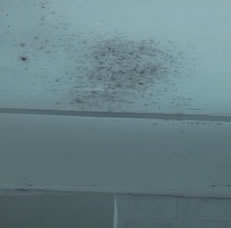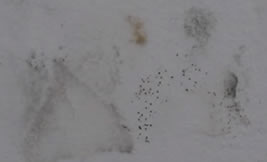Do you notice black spots on ceiling and walls? It could be caused by various reasons ranging from minor issues to major concerns.
The most common cause of black dots on walls and ceilings could be corroding fasteners that hold the drywall to wall and ceiling framing. If the black spots are uniform in size, it is most likely caused due to this reason.
However, there are other possibilities too. For instance, black stains could result from soot or nicotine as well. A nearby fireplace or regular candle burning can put black spots on ceilings and walls.
Another possibility could be mold growth. This could be easily identified if the spots are uneven in distribution, concentrated in areas, or smaller in size.
Mold growth is mainly caused because of water leakage or the condensation behind the drywall combined with the absence of air movement.
No matter, what the reason is, you should do everything in your power to get rid of the black dots. If you are looking for possible solutions, you are in the right place. Continue reading this article, because I have some important details coming up.
Black Spots On Ceiling

As discussed above these particular spots can result from various sources and it is called ghosting.
Many homeowners think that all black spots on ceiling and walls are mold growth. But that is certainly not the case.
Black dots can be caused due to the regular burning of candles or due to a possibly warm and sooty interior. When the air condenses on the sections of cold ceilings and walls. Since they are uninsulated, it forms patterns of black dots.
Now the question is whether these dots are dangerous for your health. Unless the black dots are caused due to mold growth, there is nothing to be worried about.
In this case, it doesn’t pose any health hazard to the occupants or a structural hazard to the building.
What are the black spots on my bathroom ceiling?
The most question I get, “what are the black spots on my bathroom ceiling.” Let’s answer that once and for all.
Unlike rooms, bathrooms usually don’t have multiple windows for moist air to escape. The moist air rises, and condensates on the walls of the bathroom, especially on the ceiling above the shower.
Due to lack of proper ventilation, microbial growth can occur.
Mold growth can be dangerous, especially to people who are allergic to nature. This is why you need to get rid of it as soon as you notice it.
Black Spots On Ceiling In Bathroom
Do you notice black spots on ceiling in bathroom? It is most likely the result of black mold growth. It is known as Stachybotrys Chartarum and appears as dark green or black. You can also identify it by its musty smell.
Black mold releases spores that can cause serious health issues, especially to people who are allergy problems. To prevent black mold from growing on your bathroom ceiling, you should follow these tips:
- Try to maintain the humidity level below 50%.
- Make sure that your bathroom area is well-ventilated. You can also use exhaust fans.
- Get a humidifier for your bathroom and use it, especially during the summers.
- Paint your bathroom walls and ceiling with mold-resistant paint.
- Avoid using a rug or carpet in your bathroom.
- Remove any water-damaged carpets from your bathroom.
- Clean your bathroom regularly using mold-killing products.
- Make sure that surfaces in your bathroom are dry.
How to remove black spots on the ceiling?
Now that you know the possible causes, it’s time to look for a solution. In this section, I will tell how to remove black spots on ceiling.
With a few simple steps, you can get rid of mold from your bathroom ceiling.
Here is what you need to do:
- Wash the affected area with a strong mold cleaner. You can also use a mixture of water and dish soap.
- After applying it to the affected area, allow it to dry for some time.
- Now it’s time to kill the mold using bleach. For this, prepare a mixture of one-quarter cups of bleach with one quart of water.
- Pour the solution into a spray bottle and spray it nicely on the affected area. When working with bleach, wear eye gear and protective gloves. Also, keep all the windows open for ventilation.
- If you don’t want to use bleach, you can use white vinegar. Apply straight to the area with a spray bottle and let it dry for an hour.
- Once you are done, wipe the area clean and let it dry.
Black Spots On Walls
Black spots on walls and ceilings are caused due to two main reasons. One is ghosting and the second is mold growth. I have discussed both the causes in the previous sections.
Unlike mold growth, ghosting doesn’t lead to health hazards or structural hazards to buildings. If the stains are caused due to ghosting, you can get rid of them by following the given steps.
- The first thing you need to do is eliminate indoor air particulate. For example, stop firewood, incense, or candles.
- The next step is to keep the relative humidity inside the house under check. This can be done with the help of relative humidity and temperature meter. You should maintain the humidity level below 50 to 55% during the cold winter months. You can keep the bath fans on. It will create a drying effect on your building and vent moist warm air out.
- Finally, you need to use stain-killing paint to cover up the stains. After that repaint your walls and ceilings.
Black Spots On Wall In Bathroom
The bathroom is the area in your house that has the highest moisture level. This could lead to many problems and one of them is mold growth. If you notice black spots on wall in bathroom, it is most likely caused due to mold.
Mold needs the following factors to grow and a bathroom wall has it all.
- Excessive humidity
- Dampness
- Poor insulation
- Water leak
- Warm temperature
- Determine the total size of the area that needs to be treated.
- Install the required number of air scrubbers in the affected area.
- Vacuum the entire area.
- Get rid of all porous materials.
- Clean and disinfect all surfaces.
- Fix the source of mold growth.
Black Spots On Drywall
 The sudden appearance of black spots on drywall can ruin the look of your house. Many of you would assume it to be mold growth, but it could be caused by several sources.
The sudden appearance of black spots on drywall can ruin the look of your house. Many of you would assume it to be mold growth, but it could be caused by several sources.
To fix it you need to first identify the specific cause of the black dots or marks. This will help you to come up with the best solution.
Identifying Causes
Corroded drywall fasteners lead to patterned spots. Fireplaces and candle burns can cause also form black spots on drywall.
Even insect droppings from flies and spiders may leave small, concentrated black marks on walls. But it can also be caused by mold growth, which can be toxic for your health.
Removing Simple Spots
- If they are caused by a marker or pen, you can remove them with soap and water.
- For nicotine and soot stains, you can apply a mixture of warm water and a mild detergent or soap. Use an abrasive sponge for stubborn stains.
- To clean insect droppings, you can wipe the area with a rag damp with a water and ammonia mixture.
- Apply a stain-covering primer and re-paint your walls to cover up the stains.
- For mold stains, scrub the affected area with a mixture of detergent and water. If the mold growth is severe, call a mold removal company.
Black Spots On Painted Walls
No one likes black spots on painted walls. If you are looking for ways to remove black marks from painted walls, you should try a natural remover like borax, white vinegar, and water. Get a spray bottle and a scrubber to rub the walls.
Here are the steps you need to follow:
- Take two tablespoons of borax and mix it with 1/4 cup of white vinegar and two cups of hot water in a bowl.
- Pour the solution into a spray bottle and spray it nicely on the affected areas on your walls.
- Now scrub thoroughly and wipe clean. Spray the solution again and allow it to sit for at least 10 minutes before wiping dry.
Q&A
Why am I getting mold on my bedroom ceiling?
Dampness on a ceiling can lead to mold growth. In the wintertime, ceilings are prone to dampness.
When room heating and the presence of our warm bodies send warm moist air upwards. This moist air then hits the cold ceiling and forms condensation.
What causes black spots on walls?
Black spots on walls can be the result of the mildly damp, warm, and sooty interior air. It can also be caused by mold growth or burning candles or incense.
Is black mold on drywall dangerous?
Mold releases spores that are harmful to your health. This is especially true for people who are allergic to nature.
How do I get rid of black mold on my bedroom ceiling?
To remove black mold from your bedroom ceiling, you should hire a mold remediation service.
Is it safe to clean black mold yourself?
If you want to clean black mold yourself make sure that you open all windows and doors for ventilation. Also, you need to wear protective goggles and gloves to keep yourself safe from mold spores.
Conclusion
Black spots on ceiling can result from various sources. Before you try to remove it, you need to find out the reason that’s causing it. Once you know the culprit, you can take the necessary steps to remove it.
